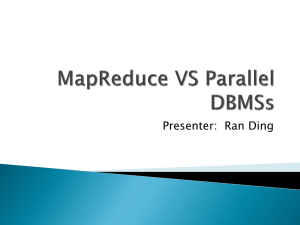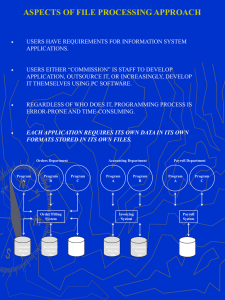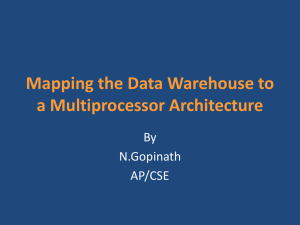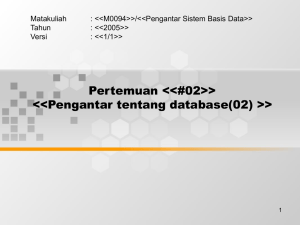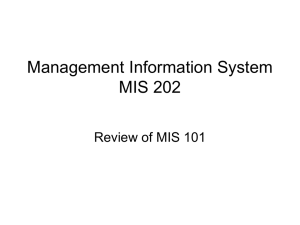1-Introduction
advertisement
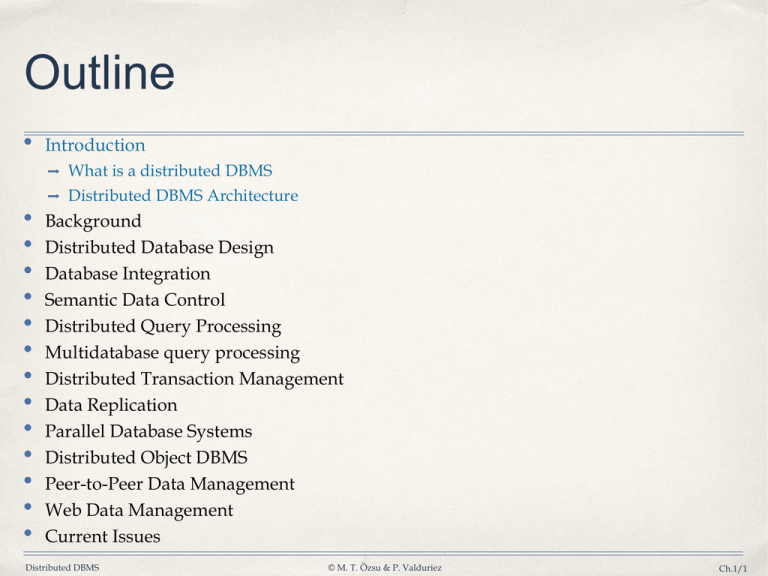
Outline
•
Introduction
➡ What is a distributed DBMS
•
•
•
•
•
•
•
•
•
•
•
•
•
➡ Distributed DBMS Architecture
Background
Distributed Database Design
Database Integration
Semantic Data Control
Distributed Query Processing
Multidatabase query processing
Distributed Transaction Management
Data Replication
Parallel Database Systems
Distributed Object DBMS
Peer-to-Peer Data Management
Web Data Management
Current Issues
Distributed DBMS
© M. T. Özsu & P. Valduriez
Ch.1/1
File Systems
program 1
File 1
data description 1
program 2
File 2
data description 2
program 3
File 3
data description 3
Distributed DBMS
© M. T. Özsu & P. Valduriez
Ch.1/2
Database Management
Application
program 1
(with data
semantics)
Application
program 2
(with data
semantics)
DBMS
description
manipulation
control
database
Application
program 3
(with data
semantics)
Distributed DBMS
© M. T. Özsu & P. Valduriez
Ch.1/3
Motivation
Database
Technology
Computer
Networks
integration
distribution
Distributed
Database
Systems
integration
integration ≠ centralization
Distributed DBMS
© M. T. Özsu & P. Valduriez
Ch.1/4
Distributed Computing
•
•
A number of autonomous processing elements (not necessarily
homogeneous) that are interconnected by a computer network and that
cooperate in performing their assigned tasks.
What is being distributed?
➡ Processing logic
➡ Function
➡ Data
➡ Control
Distributed DBMS
© M. T. Özsu & P. Valduriez
Ch.1/5
What is a Distributed Database
System?
A distributed database (DDB) is a collection of multiple, logically
interrelated databases distributed over a computer network.
A distributed database management system (D–DBMS) is the software
that manages the DDB and provides an access mechanism that makes this
distribution transparent to the users.
Distributed database system (DDBS) = DDB + D–DBMS
Distributed DBMS
© M. T. Özsu & P. Valduriez
Ch.1/6
What is not a DDBS?
•
•
•
A timesharing computer system
A loosely or tightly coupled multiprocessor system
A database system which resides at one of the nodes of a network of
computers - this is a centralized database on a network node
Distributed DBMS
© M. T. Özsu & P. Valduriez
Ch.1/7
Centralized DBMS on a Network
Site 1
Site 2
Site 5
Communication
Network
Site 4
Distributed DBMS
Site 3
© M. T. Özsu & P. Valduriez
Ch.1/8
Distributed DBMS Environment
Site 1
Site 2
Site 5
Communication
Network
Site 4
Distributed DBMS
Site 3
© M. T. Özsu & P. Valduriez
Ch.1/9
Implicit Assumptions
•
Data stored at a number of sites each site logically consists of a single
processor.
•
Processors at different sites are interconnected by a computer network
not a multiprocessor system
➡ Parallel database systems
•
•
Distributed database is a database, not a collection of files data logically
related as exhibited in the users’ access patterns
➡ Relational data model
D-DBMS is a full-fledged DBMS
➡ Not remote file system, not a TP system
Distributed DBMS
© M. T. Özsu & P. Valduriez
Ch.1/10
Data Delivery Alternatives
•
Delivery modes
➡ Pull-only
➡ Push-only
•
➡ Hybrid
Frequency
➡ Periodic
➡ Conditional
•
➡ Ad-hoc or irregular
Communication Methods
➡ Unicast
•
➡ One-to-many
Note: not all combinations make sense
Distributed DBMS
© M. T. Özsu & P. Valduriez
Ch.1/11
Distributed DBMS Promises
Transparent management of distributed, fragmented, and replicated data
Improved reliability/availability through distributed transactions
Improved performance
Easier and more economical system expansion
Distributed DBMS
© M. T. Özsu & P. Valduriez
Ch.1/12
Transparency
•
Transparency is the separation of the higher level semantics of a system
from the lower level implementation issues.
•
Fundamental issue is to provide
data independence
in the distributed environment
➡ Network (distribution) transparency
➡ Replication transparency
➡ Fragmentation transparency
✦
✦
✦
horizontal fragmentation: selection
vertical fragmentation: projection
hybrid
Distributed DBMS
© M. T. Özsu & P. Valduriez
Ch.1/13
Example
Distributed DBMS
© M. T. Özsu & P. Valduriez
Ch.1/14
Transparent Access
SELECT ENAME,SAL
FROM
Tokyo
EMP,ASG,PAY
WHERE DUR > 12
Paris
Boston
AND
EMP.ENO = ASG.ENO
AND
PAY.TITLE = EMP.TITLE
Communication
Network
Paris projects
Paris employees
Paris assignments
Boston employees
Boston projects
Boston employees
Boston assignments
Montreal
New
York
Boston projects
New York employees
New York projects
New York assignments
Distributed DBMS
© M. T. Özsu & P. Valduriez
Montreal projects
Paris projects
New York projects
with budget > 200000
Montreal employees
Montreal assignments
Ch.1/15
Distributed Database - User View
Distributed Database
Distributed DBMS
© M. T. Özsu & P. Valduriez
Ch.1/16
Distributed DBMS - Reality
User
Query
DBMS
Software
DBMS
Software
DBMS
Software
User
Application
DBMS
Software
Communication
Subsystem
User
Query
User
Application
DBMS
Software
User
Query
Distributed DBMS
© M. T. Özsu & P. Valduriez
Ch.1/17
Types of Transparency
•
•
Data independence
Network transparency (or distribution transparency)
➡ Location transparency
•
•
➡ Fragmentation transparency
Replication transparency
Fragmentation transparency
Distributed DBMS
© M. T. Özsu & P. Valduriez
Ch.1/18
Reliability Through Transactions
•
•
Replicated components and data should make distributed DBMS more
reliable.
Distributed transactions provide
➡ Concurrency transparency
➡ Failure atomicity
•
Distributed transaction support requires implementation of
➡ Distributed concurrency control protocols
•
➡ Commit protocols
Data replication
➡ Great for read-intensive workloads, problematic for updates
➡ Replication protocols
Distributed DBMS
© M. T. Özsu & P. Valduriez
Ch.1/19
Potentially Improved
Performance
•
Proximity of data to its points of use
➡ Requires some support for fragmentation and replication
•
Parallelism in execution
➡ Inter-query parallelism
➡ Intra-query parallelism
Distributed DBMS
© M. T. Özsu & P. Valduriez
Ch.1/20
Parallelism Requirements
•
Have as much of the data required by each application at the site where the
application executes
➡ Full replication
•
How about updates?
➡ Mutual consistency
➡ Freshness of copies
Distributed DBMS
© M. T. Özsu & P. Valduriez
Ch.1/21
System Expansion
•
Issue is database scaling
•
Emergence of microprocessor and workstation technologies
➡ Demise of Grosh's law
➡ Client-server model of computing
•
Data communication cost vs telecommunication cost
Distributed DBMS
© M. T. Özsu & P. Valduriez
Ch.1/22
Distributed DBMS Issues
•
Distributed Database Design
➡ How to distribute the database
➡ Replicated & non-replicated database distribution
➡ A related problem in directory management
•
Query Processing
➡ Convert user transactions to data manipulation instructions
➡ Optimization problem
✦
min{cost = data transmission + local processing}
➡ General formulation is NP-hard
Distributed DBMS
© M. T. Özsu & P. Valduriez
Ch.1/23
Distributed DBMS Issues
•
Concurrency Control
➡ Synchronization of concurrent accesses
➡ Consistency and isolation of transactions' effects
➡ Deadlock management
•
Reliability
➡ How to make the system resilient to failures
➡ Atomicity and durability
Distributed DBMS
© M. T. Özsu & P. Valduriez
Ch.1/24
Relationship Between Issues
Directory
Management
Query
Processing
Distribution
Design
Reliability
Concurrency
Control
Deadlock
Management
Distributed DBMS
© M. T. Özsu & P. Valduriez
Ch.1/25
Related Issues
•
Operating System Support
➡ Operating system with proper support for database operations
➡ Dichotomy between general purpose processing requirements and database
•
processing requirements
Open Systems and Interoperability
➡ Distributed Multidatabase Systems
➡ More probable scenario
➡ Parallel issues
Distributed DBMS
© M. T. Özsu & P. Valduriez
Ch.1/26
Architecture
•
Defines the structure of the system
➡ components identified
➡ functions of each component defined
➡ interrelationships and interactions between components defined
Distributed DBMS
© M. T. Özsu & P. Valduriez
Ch.1/27
ANSI/SPARC Architecture
Users
External
Schema
External
view
External
view
Conceptual
Schema
Conceptual
view
Internal
Schema
Internal view
Distributed DBMS
© M. T. Özsu & P. Valduriez
External
view
Ch.1/28
Generic DBMS Architecture
Distributed DBMS
© M. T. Özsu & P. Valduriez
Ch.1/29
DBMS Implementation
Alternatives
Distributed DBMS
© M. T. Özsu & P. Valduriez
Ch.1/30
Dimensions of the Problem
•
•
Distribution
➡ Whether the components of the system are located on the same machine or not
Heterogeneity
➡ Various levels (hardware, communications, operating system)
➡ DBMS important one
•
✦
data model, query language,transaction management algorithms
Autonomy
➡ Not well understood and most troublesome
➡ Various versions
✦
Design autonomy: Ability of a component DBMS to decide on issues related to its own
design.
✦
Communication autonomy: Ability of a component DBMS to decide whether and how to
communicate with other DBMSs.
✦
Execution autonomy: Ability of a component DBMS to execute local operations in any
manner it wants to.
Distributed DBMS
© M. T. Özsu & P. Valduriez
Ch.1/31
Client/Server Architecture
Distributed DBMS
© M. T. Özsu & P. Valduriez
Ch.1/32
Advantages of Client-Server
Architectures
•
•
•
•
•
•
•
More efficient division of labor
Horizontal and vertical scaling of resources
Better price/performance on client machines
Ability to use familiar tools on client machines
Client access to remote data (via standards)
Full DBMS functionality provided to client workstations
Overall better system price/performance
Distributed DBMS
© M. T. Özsu & P. Valduriez
Ch.1/33
Database Server
Distributed DBMS
© M. T. Özsu & P. Valduriez
Ch.1/34
Distributed Database Servers
Distributed DBMS
© M. T. Özsu & P. Valduriez
Ch.1/35
Datalogical Distributed DBMS
Architecture
ES1
ES2
...
ESn
GCS
Distributed DBMS
LCS1
LCS2
...
LCSn
LIS1
LIS2
...
LISn
© M. T. Özsu & P. Valduriez
Ch.1/36
Peer-to-Peer Component
Architecture
System
Log
Local
Internal
Schema
Database
Runtime
Support
Processor
Local
Conceptual
Schema
Local Recovery
Manager
GD/D
Global
Execution
Monitor
Global Query
Optimizer
USER
Global
Conceptual
Schema
Semantic Data
Controller
User
requests
User Interface
Handler
External
Schema
DATA PROCESSOR
Local Query
Processor
USER PROCESSOR
System
responses
Distributed DBMS
© M. T. Özsu & P. Valduriez
Ch.1/37
Datalogical Multi-DBMS
Architecture
LES11
Distributed DBMS
…
GES1
GES2
LES1n
GCS
...
GESn
LESn1
…
LCS1
LCS2
…
LCSn
LIS1
LIS2
…
LISn
© M. T. Özsu & P. Valduriez
LESnm
Ch.1/38
MDBS Components & Execution
Global
User
Request
Local
User
Request
Multi-DBMS
Layer
Global
Subrequest
DBMS1
Distributed DBMS
Local
User
Request
Global
Subrequest
DBMS2
© M. T. Özsu & P. Valduriez
Global
Subrequest
DBMS3
Ch.1/39
Mediator/Wrapper Architecture
Distributed DBMS
© M. T. Özsu & P. Valduriez
Ch.1/40


